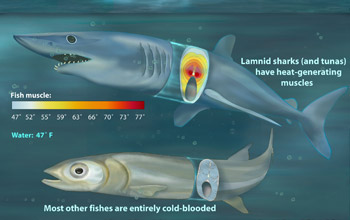All Images


Press Release 05-187
How Hot Tuna (and Some Sharks) Stay Warm

Specialized muscles generate heat and swimming power
Back to article | Note about images
 |
Lamnid sharks maintain an elevated temperature in the red muscle concentrated in their mid-region near the backbone. This specialized anatomy allows the predators to swim fast and continuously, which in turn, allows heat to be retained in the core of the fish leading to local warm-bloodedness. In most other fish, the red muscle is located close to the skin, yielding a fully cold-blooded body and only short bursts of rapid, powerful swimming.
Credit: Zina Deretsky, National Science Foundation |
Download the high-resolution JPG version of the image. (258 KB)
|
Use your mouse to right-click (or Ctrl-click on a Mac) the link above and choose the option that will save the file or target to your computer.
|
|


